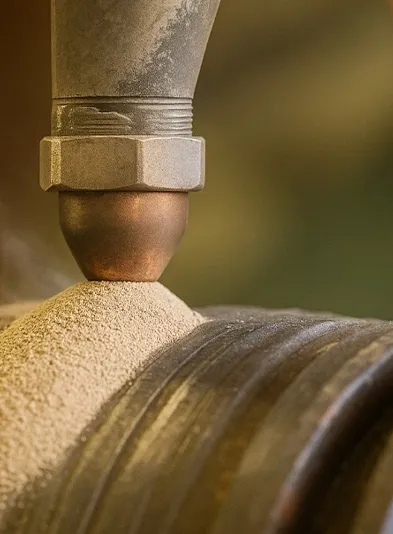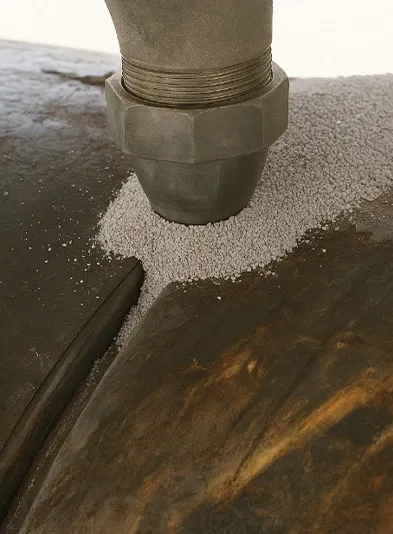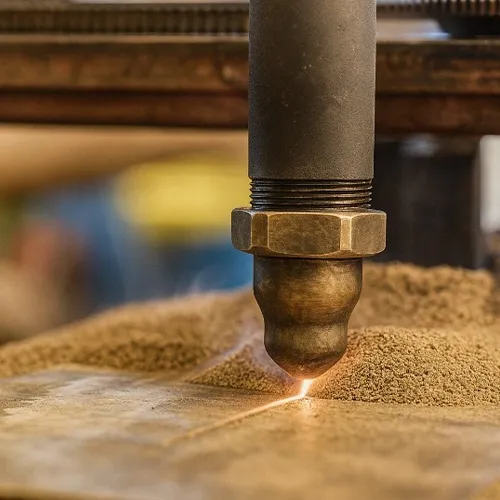Submerged arc welding flux covers the welding wire during the welding process, preventing the metal from coming into contact with air. This ensures a smoother weld seam and makes it more resistant to external factors.
Submerged arc welding flux melts under high heat, protecting the weld pool and contributing to the weld seam. This special flux is selected according to the type of material to be welded, enhancing mechanical strength and reducing welding defects. It works in harmony with automation systems during application, increasing workforce efficiency.
The key advantages of this industrial welding material are:
- Provides reliable and durable welds in the energy sector.
- Offers high efficiency in large-scale welding operations in the shipbuilding industry.
- Ensures clean and strong seams in steel construction projects.
- Offers cost advantages both economically and technically.
What is Submerged Arc Welding Flux?
Industrial welding flux is a special material that covers the wire during the welding process and forms a protective layer. This layer isolates the molten metal pool formed during welding from the atmosphere. Thus, the weld becomes cleaner, stronger, and more homogeneous.
This method, which is especially integrated with automatic systems, increases industrial efficiency. Preferred across many sectors, the product stands out with its structure that directly affects process quality.
This method allows safe applications in various alloys by using different types of welding wires. Especially when wires of varying diameter and structure are selected according to the welding type, excellent results are achieved. These combinations are commonly preferred in areas ranging from steel construction to shipbuilding. For a quality weld seam, the flux and wire must work in harmony.

Industrial welding flux is a special material that covers the wire during the welding process and forms a protective layer. This layer isolates the molten metal pool formed during welding from the atmosphere. Thus, the weld becomes cleaner, stronger, and more homogeneous.
This method, which is especially integrated with automatic systems, increases industrial efficiency. Preferred across many sectors, the product stands out with its structure that directly affects process quality.
This method allows safe applications in various alloys by using different types of welding wires. Especially when wires of varying diameter and structure are selected according to the welding type, excellent results are achieved. These combinations are commonly preferred in areas ranging from steel construction to shipbuilding. For a quality weld seam, the flux and wire must work in harmony.
In projects requiring resistance to corrosion, submerged arc welding solutions compatible with stainless surfaces stand out. Specially formulated fluxes used in such applications ensure the seam is both aesthetic and durable. Thus, post-weld surface operations are minimized, saving time.
Compared to gas-shielded welding, the submerged arc method produces much less spatter. Additionally, its low fume emission makes the work environment safer and more comfortable. This way, operator health is protected and an environmentally conscious welding process is ensured.
The following equipment and materials directly affect the quality of the submerged arc welding process:
- Cored wires that adapt to different welding surfaces are preferred during application.
- Electrodes that provide high conductivity are important for arc stability and penetration.

High-performance welding flux provides reliable, strong, and long-lasting weld connections in large-scale projects. With this aspect, it has become an indispensable method for many professionals in the industry.
Applications of Submerged Arc Welding Flux
Submerged arc welding flux, used as a protective material in welding processes, has become indispensable in many industrial fields. It is especially preferred in production processes requiring high durability, clean weld seams, and long-lasting connections.
These fluxes prevent the molten metal formed during welding from coming into contact with oxygen and other gases, increasing the quality of the weld seam. As a result, mechanical strength improves and more resistant structures are obtained against external factors.
Protective welding flux is widely used in the following sectors:
- Power plants: Used to create connections resistant to high temperatures and pressure. Provides long-lasting and reliable weld seams.
- Heavy machinery manufacturing: Preferred for creating high penetration and smooth weld lines in large and thick parts.
- Shipyards and shipbuilding: Forms smooth and homogeneous weld seams when joining large surface metal plates.
- Pipeline manufacturing: Ideal for forming leak-proof weld seams especially in pressure-resistant pipe systems.
- Petrochemical facilities: Used to create connections resistant to chemicals and corrosive gases.
- Automotive and train manufacturing: Plays an important role in the welding of structural systems requiring precision and strength.
- Steel construction projects: Widely used in the skeletal systems of high-rise buildings to ensure structural safety.
The compatibility of this industrial welding material with different wire types and alloys further expands its range of applications. Thus, it can be applied efficiently in mass production lines and special projects. Thanks to its compatible structure and quality advantages, submerged arc welding flux has become one of the cornerstones of modern industrial production.
To increase efficiency in industry, you can contact Eko Kaynak.

